Offshore rigs
Offshore rigs
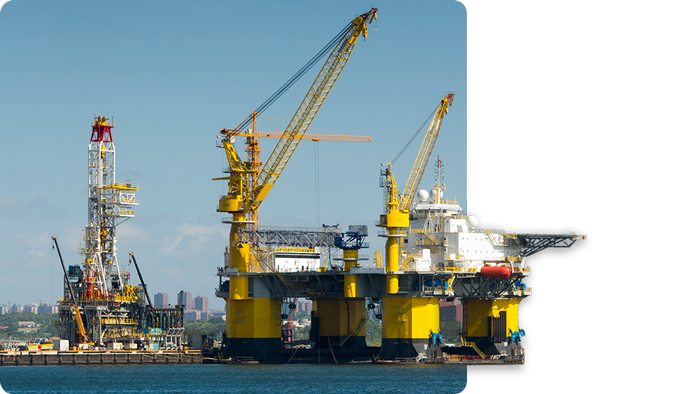
Offshore rigs
Inventory Control and limited space are essential aspects in selecting material handling systems onboard offshore (drilling) rigs such as; semi-subs, jack-ups and drilling ships. Lion specially designs integrated dry bulk material handling and drilling fluid mixing systems with remote operations for offshore drilling rigs and platforms. The dry bulk – cement, barite and bentonite – is stored in pressure tanks or atmospheric silos and subsequently transported and unloaded from supply ships to offshore drilling rigs or platforms. This process has to be efficient, economical and dust-free before using the dry materials in the mud mixing process. All our offshore material handling systems meet the highest international standards.
The following configurations are available for offshore rigs:
Click on a blue link to jump to your preferred section.
Dry Bulk Management
> Pressure Tank System
> Sender Tank System
> Re-Loader Tank System
Drilling Fluid Management
> Mud Mixing System
> Mud Circulation and Transfer
> Big Bag Mixing Unit
System Configurations
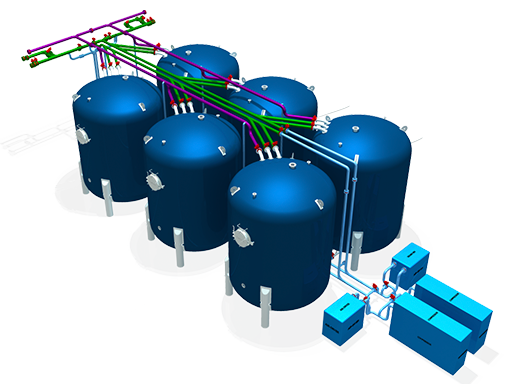
Pressure tank system
The pressure tank or P-tank system is a conventional system used on Offshore Vessels. The system deploys several pressure tanks to receive, store and discharge cement and drilling powders on board. Dry bulk cargo is fluidized in the tanks by compressed air, then discharged via the pipes and hoses to the rig tanks. The bulk material is loaded and unloaded pneumatically, using compressed air to convey the powder.
KEY BENEFITS
-
High system reliability
-
Option to use weight monitoring system
-
Easy operation, using various degrees of automation
-
Multiple independent systems possible, prevents contamination.
-
Arranged with 4-10 tanks.
TECHNICAL DETAILS
Max. Cargo Capacity: Up to 500 T
Max. Convey Capacity: Up to 115 TPH
Max. Cargo Capacity:
Up to 500 T
Max. Convey Capacity:
Up to 115 TPH
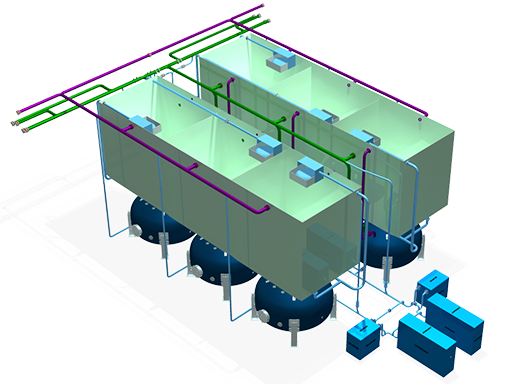
Sender tank system
The sender tank system is a bulk handling system using several atmospheric, hull-integrated hoppers to transport cement and drilling powders from shore to offshore destinations. Material is loaded pneumatically from shore. Small pressure tanks underneath the hoppers are filled and pressurised for unloading to a rig to pneumatically convey the bulk material through the pipe and hose routing.
KEY BENEFITS
-
Hull-integrated storage tanks
-
Highly reliable pneumatic system
-
High volume, small footprint
-
Continuous bulk flow in dual mode
-
High energy efficiency
-
Various degrees of automation
-
Small pressure tanks, less risks
TECHNICAL DETAILS
Max. Cargo Capacity: Up to 2.000 T
Max. Convey Capacity: Up to 115 TPH
Max. Cargo Capacity:
Up to 2.000 T
Max. Convey Capacity:
Up to 115 TPH
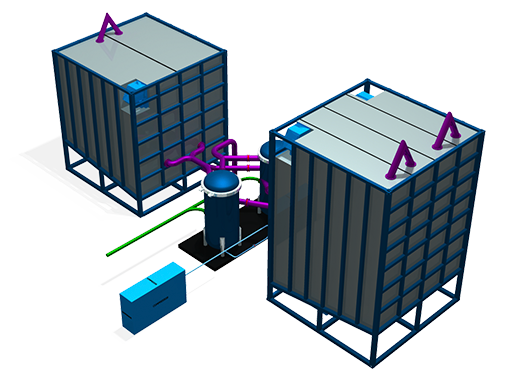
Re-loader tank system
The re-loader or double re-loader tank systems are used to store dry bulk material onboard offshore vessels. The system uses several atmospheric hoppers to store cement and drilling powders. The material enters a re-loader tank, which is then pressurised to convey the powder towards the rig tanks pneumatically. Vacuum is used to remove material from the hoppers.
KEY BENEFITS
-
Hull-integrated storage tanks or freestanding modular design deck tanks
-
Proven pneumatic system
-
Maximum volume and minimum footprint
-
Fully automated
-
Only two pressure tanks needed, smaller risks
-
Vacuum-Pressure System
TECHNICAL DETAILS
Max. Cargo Capacity: Up to 2.000 T
Max. Convey Capacity: Up to 115 TPH
Max. Cargo Capacity:
Up to 2.000 T
Max. Convey Capacity:
Up to 115 TPH
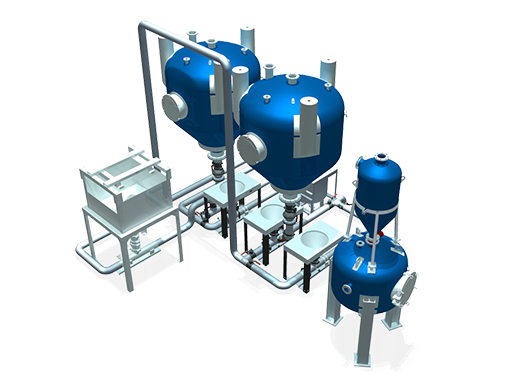
mud mixing system
The sophistication and cost required to produce a drilling mud that stabilises the hole, seal the pore spaces, controls bottom hole pressure, and limits formation damage require new, efficient, and practical solutions. Combined with our bulk handling systems, Lion’s mud mixing systems meet the industry’s needs for a complete bulk handling and mud mixing package for modern drilling rigs. The Ruyter Offshore mixing eductor is used to add dry bentonite and barite to fluid to create drilling mud. Our mud mixing systems thoroughly mix the drilling mud and the required additives. The Ruyter Offshore Twin Jet Stream SMX comes in a dual suction model that connects directly to the surge tank. This connection eliminates dust during the mixing process. The design of the nozzle and diffuser eliminates plugging during the mud mixing.
KEY BENEFITS
-
Excellent rheology
-
No clumps or fisheyes
-
No rotating parts
-
Dust-free mixing
-
Non plugging eductor
-
Easy maintenance
TECHNICAL DETAILS
Max. Cargo Capacity: 80m3
Max. Convey Capacity: 1.500 Kg/min
Max. Cargo Capacity:
80m3
Max. Convey Capacity:
1.500 Kg/min
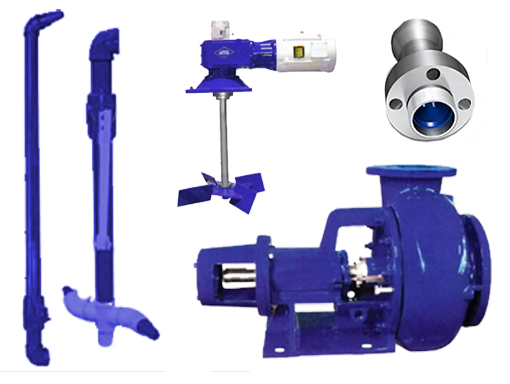
Mud circulation and transfer
Drilling fluid, also known as liquid mud, is a weighted liquid. A gelled liquid is created first, generally using bentonite. Next, barite is added to increase density, allowing a certain degree of pressure to maintain the well. This prevents the unwanted influx of formation liquids. Barite is suspended in the fluid but does not dissolve. Circulation systems are required to keep barite in suspension. The purpose of the mud circulation system is to achieve and maintain proper rheology in the mud. A set of circulating eductors, the design of which depends on tank geometry in combination with an agitator, maintains a sufficient degree of internal flow in the tank.
KEY BENEFITS
-
Excellent rheology
-
Energy efficiency
-
No barite losses
-
Sturdy and reliable
-
No cleaning of settled barite in tank corners required
TECHNICAL DETAILS
Max. Cargo Capacity Up to 1.000 m3
Max. Convey Capacity:
Max. Cargo Capacity:
Up to 1.000 m3
Max. Convey Capacity:
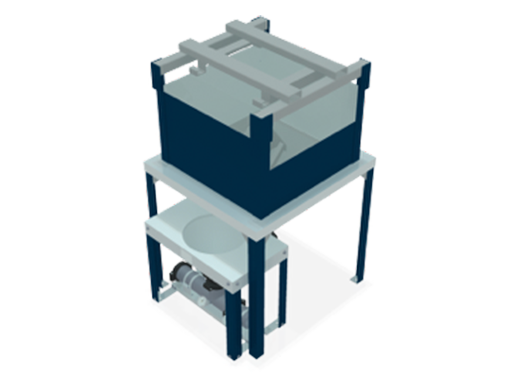
Big bag mixing unit
The big bag mixing unit (BBMU) is designed for the safe handling and efficient unloading of big bags (super sacks) while eliminating dust pollution during product mixing. Coupling the six-inch shear mixer with the big bag units (BBU) allows 1.500 Kg of product to be mixed in less than five minutes. The bag slitter opens the disposable big bag and the vacuum – created by the shearing mixer – extracts the product into the shearing mixer, rapidly hydrating and mixing it.
The big bag handling assembly lifts the bag into place and keeps it from folding into the containment bin. As the big bag empties, the lifting assembly contacts the upper rails of the big bag frame and keeps the bag taut to ensure the free flow of the product. Should the big bag be lifted off the bag slitter, the containment bin will keep the product from spilling onto the ground. The bag slitter is designed to pierce the bottom of the disposable bag using its own weight, with the arms extending outward from the slitter to open the bag fully and let gravity ensure free flow of the product.
KEY BENEFITS
-
Excellent rheology
-
No clumps or fisheyes
-
No rotating parts
-
Dust-free mixing
-
Non plugging eductor
-
Easy maintenance
TECHNICAL DETAILS
Max. Cargo Capacity: Up to 1.500 Kg
Max. Convey Capacity: 1.500 Kg/min
Max. Cargo Capacity:
Up to 1.500 Kg
Max. Convey Capacity:
1.500 Kg/min


